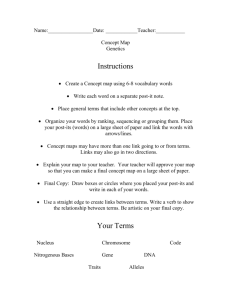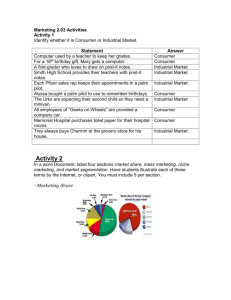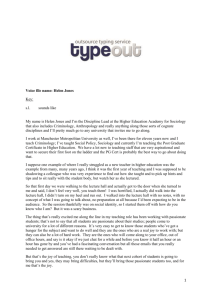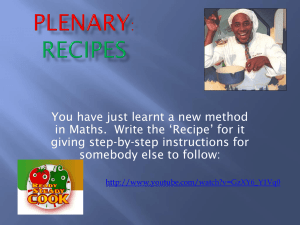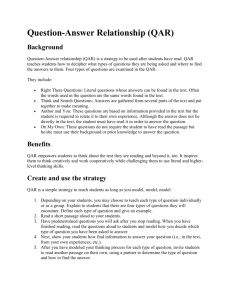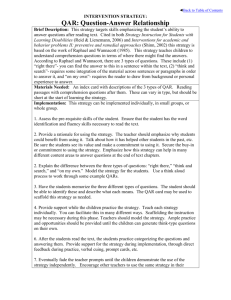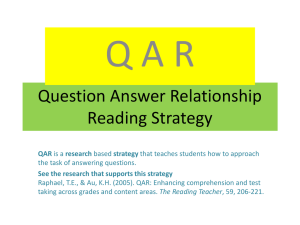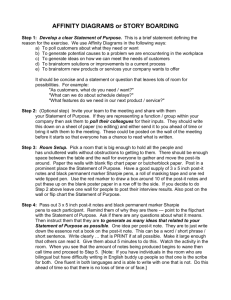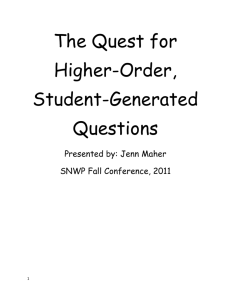Post_its_presentation - kentuckycouncilofteachersofenglish
advertisement
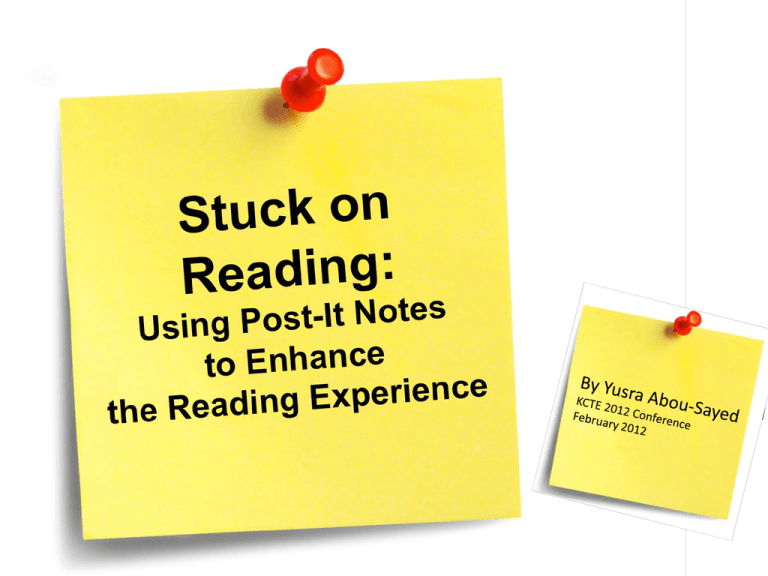
What do good readers do? Reading Comprehension • • • • • • • Activating and Connecting Prior Knowledge Vocabulary Questioning Visualizing and Inferring Determining Importance Summarizing and Synthesizing Information Monitoring Comprehension Activating and Connecting Prior Knowledge • K-W-L Chart – What do you know about post-its in the classroom? • Noticing and Thinking about New Learning • Color-coded connections (T-T, T-S, T-W) – Example Oh, How I Wished I Could Read, by John Gile Vocabulary • Mark unknown words in texts • Hot potato Vocabulary Hot Potato Vocabulary 1. Students play "hot potato" with a canister to music. 2. When the music stops, the student holding the canister opens the canister and pulls out a tongue depressor with a Post-it® tab on the top. They have to define the word written on the tongue depressor in any way they want (act it out, illustrate, etc.). Words can be taken from previously read texts. 3. If they get it right, they place the post-it on a chart next to their name. If they don't get it right, they have to pass the stick to the next person. Adapted from Post-Its Activity Center Questioning • Model questioning with adult text • Ask-it question (during read aloud or shared reading) • QAR Strategy • Thick and Thin questions – Read Write Think Lesson • What a Question! Question-Answer Relationships (QAR) QAR Activity • After a lesson on Question-Answer-Relationships, students come up with their own questions based on the QAR. An example is shown here: Mrs. McCumbee’s Class What a Question 1. Distribute a post-it note to each student. 2. Instruct them to read the text (or do it during shared reading). 3. Ask each student to write one question about the text (using a Questioning-Stem as a guide) and post it on the board. 4. Each student will select a question to answer about the text. If the question is answered correctly, the student that wrote it stands up. If the answer is not answered correctly, the class will work together to find the answer. Bloom’s Taxonomy Question Stems #1 Bloom’s Taxonomy Question Stems #2 Activity adapted from Post-It Activity Center Visualizing and Inferring • Identify specific features in non-fiction texts • Powerlines • Lines that contain vivid imagery • Wordless Picture Books (activity) • Drawing a picture from a vivid passage Determining Importance • Finding Important Information vs. One Main Idea Finding Important Information vs One Main Idea • Each student has a copy of the same text • Three sticky notes each, students mark what they consider to be the three most important ideas in the text with a (*) • Students discuss and defend their important information; there isn’t always just ONE main idea Summarizing and Synthesizing Information • Simple book review/critique • Page-by-Page summary during shared reading • Post-it Summary • Story sequencing (B-M-E) Synthesizing Monitoring Comprehension • Inner Conversation • “Huh” strategy (knowing when you don’t know) • Noticing and Exploring Thinking • Read, Cover, Remember Read, Cover, Remember • Have students monitor their comprehension while reading by covering the page, writing the gist of what they read, then checking their understanding. Story Elements The Picnic Pals Responding to Literature and Extending Learning Reaction Wall Following the reading of a text, students will write their reaction to a text and post it on the wall. After each student has reacted to the text, they will share their reaction with other students and discuss them. Wondering Wall Have students write questions they have about various subjects on a sticky note. Visit the wall throughout the year and research the answers. This is a great way to extend learning. Food For Thought “When readers interact with the text, they are more apt to stay on top of the meaning as they read.” –Harvey and Goudvis, Strategies that Work References •http://www.busyteacherscafe.com/literacy/comprehension_strategies.html •Http://www.readinglady.com •http://teachers.post-it.com/wps/portal/3M/en_US/Post-it-Teachers/Home/ •Strategies That Work, Harvey & Goudvis, Stenhouse
